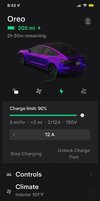Define ”overdischarge” for your self.
The battery manufacturers and researchers define it as discharging the battery cell beyond the designed limit.
We can not discharge the battery beyond the limit as the car will shut down the battery via the cobtactors before we reach that limit. Thats also, correct, stated in the document STS-134 refers to:
View attachment 799747
The same document refers to this test:
View attachment 799748
Its only one of very many showing the same thing.
How come the battery cycled down to 0% SOC has the absolutely, by a wide margin, the lowest degradation?
Cycled down to 0% caused 3% degradation. Cycled down to 20% has 9% degradation.
How would the battery thats cycled to 20% have 3X degradation if the one cycled in the dangerous ”overdischarge” region ?
If you start reading resesrch reports you will find that:
100% SOC = the state with the maximum cell voltage
0% SOC = the state with lowest cell voltage(actually stopped discharging at lowest voltage, and regains voltage at rest after the discharge cycle.
Capacity = the energy delivered between 100 and 0% SOC.
Overdischarge= discharging the battery beyond the specified limit.
There is also research reports about overdischarge. For batterys with 2.5V discharge limit there was hardly any damage detected if discharged down to 2.0 Volts. The damage occured if dischsrged to lower than 2.0V.
ALL data show that 0% is safe. 0% is
not overdischarge.



